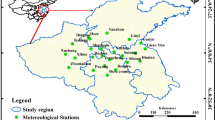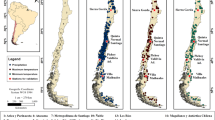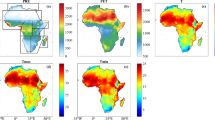Abstract
Global warming brings a huge challenge to society and human being. Understanding historic and future potential climate change will be beneficial to regional crop, forest, and water management. This study aims to analyze the precipitation and temperature changes in the historic period and future period 2021–2050 in the Xiangjiang River Basin, China. The Mann–Kendall rank test for trend and change point analysis was used to analyze the changes in trend and magnitude based on historic precipitation and temperature time series. Four global climate models (GCMs) and a statistical downscaling approach, LARS-WG, were used to estimate future precipitation and temperature under RCP4.5. The results show that annual precipitation in the basin is increasing, although not significant, and will probably continue to increase in the future on the basis of ensemble projections of four GCMs. Temperature is increasing in a significant way and all GCMs projected continuous temperature increase in the future. There will be more extreme events in the future, including both extreme precipitation and temperature.













Similar content being viewed by others
References
Ageena I, Macdonald N, Morse AP (2014) Variability of minimum temperature across Libya (1945–2009). Int J Climatol 33:641–653. doi:10.1002/joc.3452
Cinco TA, de Guzman RG, Hilario FD, Wilson DM (2014) Long-term trends and extremes in observed daily precipitation and near surface air temperature in the Philippines for the period 1951–2010. Atmospher Res 145–146:12–26. doi:10.1016/j.atmosres.2014.03.025
Douglas EM, Vogel RM, Kroll CN (2000) Trends in floods and low flows in the United States: impact of spatial correlation. J Hydrol 240:90–105. doi:10.1016/S0022-1694(00)00336-X
Guo Y, Wang C (2014) Trends in precipitation recycling over the Qinghai–Xizang Plateau in last decades Journal of Hydrology 517:826-835 doi:http://dx.doi.org/10.1016/j.jhydrol.2014.06.006
Hessami M, Gachon P, Ouarda TBMJ, St-Hilaire A (2008) Automated regression-based statistical downscaling tool. Environ Model Softw 23:813–834. doi:10.1016/j.envsoft.2007.10.004
Hong SY, Moon NK, Lim SS, Kim JW (2010) Future climate change scenarios over Korea using a multi-nested downscaling system: a pilot study. Asia-Pacific J AtmospheR Sci 48:325–337. doi:10.1007/s13143-010-0024-1
Hu L, Peng D, Tang S, Chen H, Xiao Y (2011) Impact of climate change on hydro-climatic variables in Xiangjiang River Basin, China. In: Water Resource and Environmental Protection (ISWREP), 2011 International Symposium, 20–22 May
Im ES, Ahn JB, Kim DW (2012) An assessment of future dryness over Korea based on the ECHAM5-RegCM3 model chain under A1B emission scenario. Asia-Pac J Atmos Sci 48:325–337. doi:10.1007/s13143-012-0031-5
Kay AL, Davies HN, Bell VA, Jones RG (2009) Comparison of uncertainty sources for climate change impacts: flood frequency in England Climatic Change 92:41-63 doi:http://dx.doi.org/10.1007/s10584-008-9471-4
Kendall MG (1975) Rank correlation methods. Griffin, London, England
Kim C, Suh MS (2013) Prospects of using Bayesian model averaging for the calibration of one-month forecasts of surface air temperature over South Korea. Asia-Pac J Atmos Sci 49:301–311. doi:10.1007/s13143-013-0029-7
Lee JW, Ham S, Hong SY, Yoshimura K, Joh M (2014a) Future changes in surface runoff over Korea projected by a regional climate model under A1B scenario. Adv Meteorol 2014:753790. doi:10.1155/2014/753790
Lee JW, Hong SY, Chang EC, Suh MS, Kang HS (2014b) Assessment of future climate change over East Asia due to the RCP scenarios downscaled by GRIMs-RMP. Clim Dyn 42:733–747. doi:10.1007/s00382-013-1841-6
Lee J-W, Hong S-Y (2014) Potential for added value to downscaled climate extremes over Korea by increased resolution of a regional climate model. Theor Appl Climatol 117:667–677. doi:10.1007/s00704-013-1034-6
Mann HB (1945) NONPARAMETRIC TESTS AGAINST TREND Econometrica (pre-1986) 13:245
Min YM, Kryjov VN, An KH, Hameed SN, Sohn SJ, Lee WJ, Oh JH (2011) Evaluation of the weather generator CLIGEN with daily precipitation characteristics in Korea. Asia-Pac J Atmos Sci 47(3):255–263. doi:10.1007/s13143-011-0014-y
Najafi MR, Moradkhani H, Jung IW (2011) Assessing the uncertainties of hydrologic model selection in climate change impact studies. Hydrol Process 25(18):2814–2826. doi:10.1002/hyp.8043
Nicks AD, Lane LJ, Gander GA (1995) Chapter 2, Weather generator. In: Flanagan DC, Nearing MA (eds) USDA-Water Erosion Prediction Project: Hillslope Profile and Watershed Model Documentation, National Soil Erosion Research Laboratory, USDA Agricultural Research Service, West Lafayette, IN
Oh SG, Suh MS, Cha DH (2013) Impact of lateral boundary conditions on precipitation and temperature extremes over South Korea in the CORDEX Regional climate simulation using RegCM4. Asia-Pac J Atmos Sci 49(4):597–509. doi:10.1007/s13143-013-0044-8
Qian B, Gameda S, Hayhoe H, Jong RD, Bootsma A (2004) Comparison of LARS-WG and AAFC-WG stochastic weather generators for diverse Canadian climates. Clim Res 26:175–191. doi:10.3354/cr026175
Racsko P, Szeidl L, Semenov M (1991) A serial approach to local stochastic weather models. Ecol Modell 57(1–2):27–41. doi:10.1016/0304-3800(91)90053-4
Semmler T, Jacob D (2004) Modeling extreme precipitation events—a climate change simulation for Europe Global and Planetary Change 44:119-127 doi:http://dx.doi.org/10.1016/j.gloplacha.2004.06.008
Semenov MA (2008) Simulation of extreme weather events by a stochastic weather generator. Clim Res 35:203–212. doi:10.3354/cr00731
Semenov MA, Stratonovitch P (2010) Use of multi-model ensembles from global climate models for assessment of climate change impacts. Clim Res 40(1):1–14. doi:10.3354/cr00836
Semenov MA, Brooks RJ, Barrow EM, Richardson CW (1998) Comparison of the WGEN and LARS-WG stochastic weather generators in diverse climates. Clim Res 10:95–107. doi:10.3354/cr010095
Stockle CO, Nelson R (1999) ClimGen: a weather generator program. Washington State University, Biological Systems Engineering Dept, Pullman, WA
Suryavanshi S, Pandey A, Chaube U, Joshi N (2014) Long-term historic changes in climatic variables of Betwa Basin. India Theoret Appl Climatol 117:403–418. doi:10.1007/s00704-013-1013-y
Tebaldi C, Hayhoe K, Arblaster J, Meehl G (2007) Going to the extremes. Clim Chang 82:233–234. doi:10.1007/s10584-007-9247-2
Tian Y, Xu Y-P, Booij MJ, Lin S, Zhang Q, Lou Z (2012) Detection of trends in precipitation extremes in Zhejiang, east China. Theor Appl Climatol 107:201–210. doi:10.1007/s00704-011-0472-2
Tian Y, Xu Y-P, Booij MJ, Wang G (2015) Uncertainty in future high flows in Qiantang River Basin, China. J Hydrometrolo 16(1):363–380. doi:10.1175/JHM-D-13-0136.1
Tripathi S, Srinivas VV, Nanjundiah RS (2006) Downscaling of precipitation for climate change scenarios: a support vector machine approach. J Hydrol 330:621–640. doi:10.1016/j.jhydrol.2006.04.030
Vincent LA, Mekis E (2006) Changes in daily and extreme temperature and precipitation indices for Canada over the Twentieth Century. Atmosphere-Ocean 44:177–193. doi:10.3137/ao.440205
Wilby RL, Harris I (2006) A framework for assessing uncertainties in climate change impacts: low-flow scenarios for the River Thames. UK Water Res Res 42:W02419. doi:10.1029/2005WR004065
Willems P, Vrac M (2011) Statistical precipitation downscaling for small-scale hydrological impact investigations of climate change Journal of Hydrology 402:193-205 doi:http://dx.doi.org/10.1016/j.jhydrol.2011.02.030
Woldemeskel FM, Sharma A, Sivakumar B, Mehrotra R (2012) An error estimation method for precipitation and temperature projections for future climates. J Geophys Res Atmospheres 117:D22104. doi:10.1029/2012JD018062
Xu H, Xu C-Y, Chen H, Zhang Z, Li L (2013) Assessing the influence of rain gauge density and distribution on hydrological model performance in a humid region of China. J Hydrol 505:1–12. doi:10.1016/j.jhydrol.2013.09.004
Xu YP, Zhang X, Tian Y (2012) Impact of climate change on 24-h design rainfall depth estimation in Qiantang River Basin, East China. Hydrol Process 26:4067–4077. doi:10.1002/hyp.9210
Yue S, Pilon P, Phinney B (2003) Canadian streamflow trend detection: impacts of serial and cross-correlation. Hydrol Sci J 48:51–63
Yue S, Pilon P, Phinney B, Cavadias G (2002) The influence of autocorrelation on the ability to detect trend in hydrological series. Hydrol Process 16:1807–1829. doi:10.1002/hyp.1095
Zhang X, Vincent LA, Hogg W, Niitsoo A (2000) Temperature and precipitation trends in Canada during the 20th century. Atmosphere-Ocean 38:395–429
Zhang X, Xu Y-P, Fu G (2014) Uncertainties in SWAT extreme flow simulation under climate change. J Hydrol 515:205–222. doi:10.1016/j.jhydrol.2014.04.064
Zhu Y (2009) Analysis on water resource safety issues of Xiangjiang River Basin. Hunan Hydro & Power. (4): 35-37,43 (in Chinese with an English abstract)
Acknowledgments
This study is financially supported by the Nature Science Foundation of China (Project No. 51379183). Acknowledgments are given to the National Climate Center of China Meteorological Administration and Hunan Climate Center for providing meteorological data.
Author information
Authors and Affiliations
Corresponding author
Rights and permissions
About this article
Cite this article
Ma, C., Pan, S., Wang, G. et al. Changes in precipitation and temperature in Xiangjiang River Basin, China. Theor Appl Climatol 123, 859–871 (2016). https://doi.org/10.1007/s00704-015-1386-1
Received:
Accepted:
Published:
Issue Date:
DOI: https://doi.org/10.1007/s00704-015-1386-1




